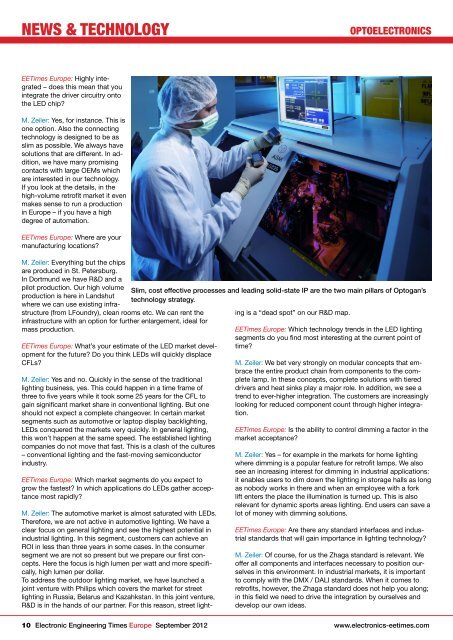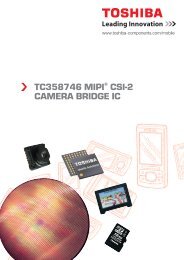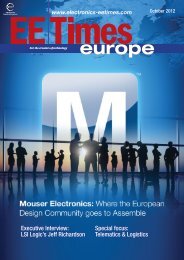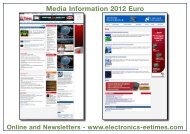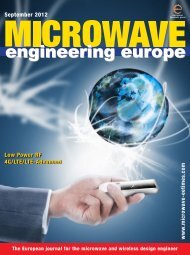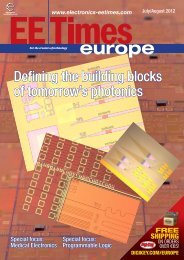Energy harvesting: a thin film approach - EE Times Europe
Energy harvesting: a thin film approach - EE Times Europe
Energy harvesting: a thin film approach - EE Times Europe
Create successful ePaper yourself
Turn your PDF publications into a flip-book with our unique Google optimized e-Paper software.
NEWS & TECHNOLOGY<br />
OPTOELECTRONICS<br />
<strong>EE</strong><strong>Times</strong> <strong>Europe</strong>: Highly integrated<br />
– does this mean that you<br />
integrate the driver circuitry onto<br />
the LED chip?<br />
M. Zeiler: Yes, for instance. This is<br />
one option. Also the connecting<br />
technology is designed to be as<br />
slim as possible. We always have<br />
solutions that are different. In addition,<br />
we have many promising<br />
contacts with large OEMs which<br />
are interested in our technology.<br />
If you look at the details, in the<br />
high-volume retrofit market it even<br />
makes sense to run a production<br />
in <strong>Europe</strong> – if you have a high<br />
degree of automation.<br />
<strong>EE</strong><strong>Times</strong> <strong>Europe</strong>: Where are your<br />
manufacturing locations?<br />
M. Zeiler: Every<strong>thin</strong>g but the chips<br />
are produced in St. Petersburg.<br />
In Dortmund we have R&D and a<br />
pilot production. Our high volume<br />
production is here in Landshut<br />
where we can use existing infrastructure<br />
(from LFoundry), clean rooms etc. We can rent the<br />
infrastructure with an option for further enlargement, ideal for<br />
mass production.<br />
<strong>EE</strong><strong>Times</strong> <strong>Europe</strong>: What’s your estimate of the LED market development<br />
for the future? Do you <strong>thin</strong>k LEDs will quickly displace<br />
CFLs?<br />
M. Zeiler: Yes and no. Quickly in the sense of the traditional<br />
lighting business, yes. This could happen in a time frame of<br />
three to five years while it took some 25 years for the CFL to<br />
gain significant market share in conventional lighting. But one<br />
should not expect a complete changeover. In certain market<br />
segments such as automotive or laptop display backlighting,<br />
LEDs conquered the markets very quickly. In general lighting,<br />
this won’t happen at the same speed. The established lighting<br />
companies do not move that fast. This is a clash of the cultures<br />
– conventional lighting and the fast-moving semiconductor<br />
industry.<br />
<strong>EE</strong><strong>Times</strong> <strong>Europe</strong>: Which market segments do you expect to<br />
grow the fastest? In which applications do LEDs gather acceptance<br />
most rapidly?<br />
Slim, cost effective processes and leading solid-state IP are the two main pillars of Optogan’s<br />
technology strategy.<br />
M. Zeiler: The automotive market is almost saturated with LEDs.<br />
Therefore, we are not active in automotive lighting. We have a<br />
clear focus on general lighting and see the highest potential in<br />
industrial lighting. In this segment, customers can achieve an<br />
ROI in less than three years in some cases. In the consumer<br />
segment we are not so present but we prepare our first concepts.<br />
Here the focus is high lumen per watt and more specifically,<br />
high lumen per dollar.<br />
To address the outdoor lighting market, we have launched a<br />
joint venture with Philips which covers the market for street<br />
lighting in Russia, Belarus and Kazahkstan. In this joint venture,<br />
R&D is in the hands of our partner. For this reason, street lighting<br />
is a “dead spot” on our R&D map.<br />
<strong>EE</strong><strong>Times</strong> <strong>Europe</strong>: Which technology trends in the LED lighting<br />
segments do you find most interesting at the current point of<br />
time?<br />
M. Zeiler: We bet very strongly on modular concepts that embrace<br />
the entire product chain from components to the complete<br />
lamp. In these concepts, complete solutions with tiered<br />
drivers and heat sinks play a major role. In addition, we see a<br />
trend to ever-higher integration. The customers are increasingly<br />
looking for reduced component count through higher integration.<br />
<strong>EE</strong><strong>Times</strong> <strong>Europe</strong>: Is the ability to control dimming a factor in the<br />
market acceptance?<br />
M. Zeiler: Yes – for example in the markets for home lighting<br />
where dimming is a popular feature for retrofit lamps. We also<br />
see an increasing interest for dimming in industrial applications:<br />
it enables users to dim down the lighting in storage halls as long<br />
as nobody works in there and when an employee with a fork<br />
lift enters the place the illumination is turned up. This is also<br />
relevant for dynamic sports areas lighting. End users can save a<br />
lot of money with dimming solutions.<br />
<strong>EE</strong><strong>Times</strong> <strong>Europe</strong>: Are there any standard interfaces and industrial<br />
standards that will gain importance in lighting technology?<br />
M. Zeiler: Of course, for us the Zhaga standard is relevant. We<br />
offer all components and interfaces necessary to position ourselves<br />
in this environment. In industrial markets, it is important<br />
to comply with the DMX / DALI standards. When it comes to<br />
retrofits, however, the Zhaga standard does not help you along;<br />
in this field we need to drive the integration by ourselves and<br />
develop our own ideas.<br />
10 Electronic Engineering <strong>Times</strong> <strong>Europe</strong> September 2012 www.electronics-eetimes.com


